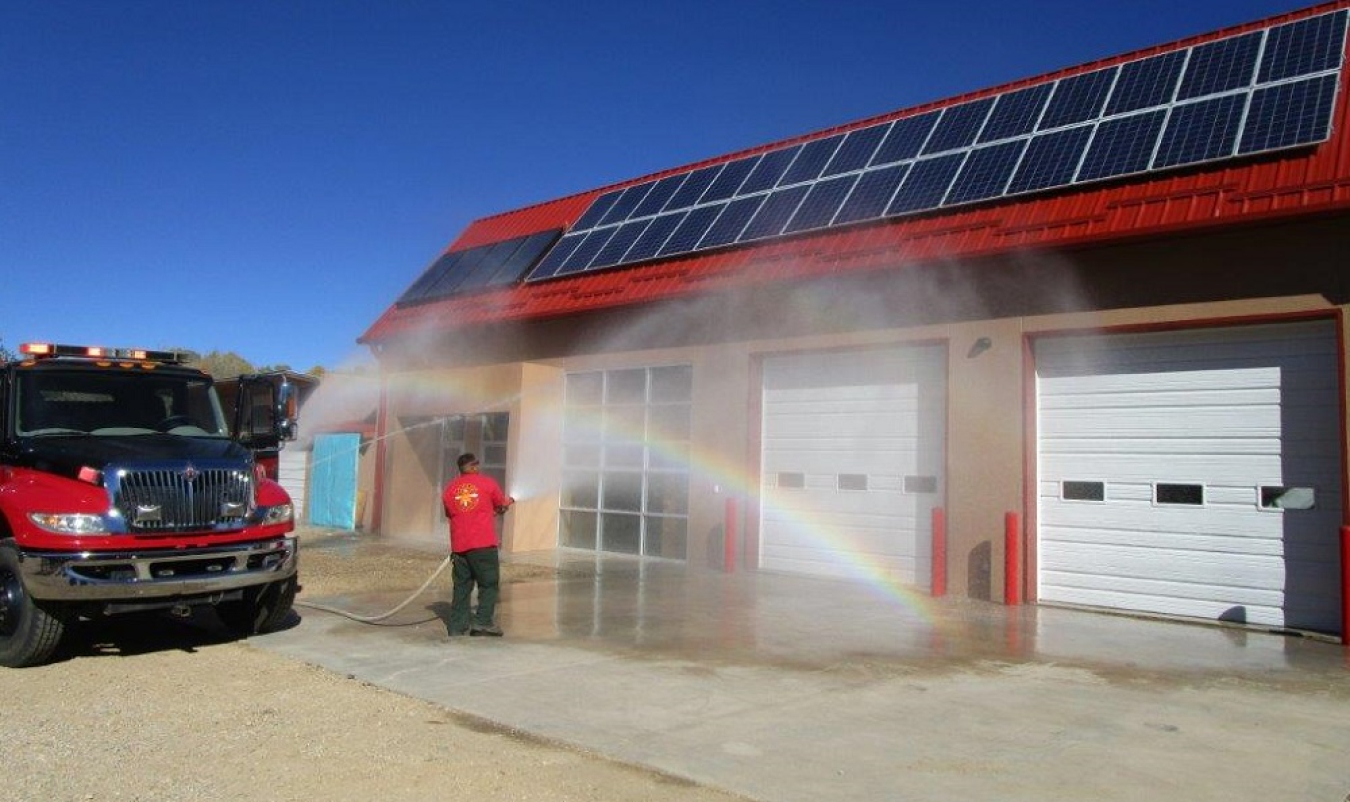
It may not have been your typical open house since it included a baptism. But this baptism didn’t involve a baby. It was a building—New Mexico’s first net zero energy building. On Oct. 14, 2015, in Peñasco, about 50 miles north of Santa Fe, the Picuris Pueblo held an open house for the grand opening of its new solar-powered fire station and renovated gymnasium. As a fire engine siren wailed, the pueblo fire department crew “baptized” their new station according to firefighting tradition, kicking off a celebration of the community’s recent achievements.
In addition to the initiation of a new 2,640-square-foot fire station, the event included the dedication of a new gymnasium as well as presentations on various economic development initiatives, including plans to develop a $3 million travel center and a 1-megawatt (MW) solar array by the end of 2016.
Joshua Sanchez from U.S. Sen. Tom Udall’s office said that for Picuris, the smallest of New Mexico’s 19 pueblos, the fire station and gymnasium are “a tremendous accomplishment.”
The U.S. Department of Energy (DOE) Office of Indian Energy is assisting Picuris Pueblo with the solar project through its Strategic Technical Assistance Response Team (START) Program. Picuris is one of five American Indian Tribes in the 48 contiguous states receiving on-the-ground support with developing and deploying renewable energy projects.
Through START, teams of DOE and national laboratory technical experts provide customized technical support, working directly with the tribal project team and legal and financial specialists. A team from DOE’s National Renewable Energy Laboratory (NREL) is assisting Picuris with advancing its 1-MW solar project. Some of the planned assistance includes:
- Reviewing preliminary system performance modeling
- Guiding the project team on timing to comply with environmental requirements
- Providing feedback on pre-engineering studies and the proposed power purchase agreement
- Analyzing project financing structures
- Assessing proposals in support of the selection process for solar system developers.
Gary Pyne, Governor of Picuris Pueblo, explained that in 2008, Picuris installed a solar panel to offset the operating cost of the community’s drinking water well and pump station, which marked the pueblo’s first step toward fulfilling its renewable energy vision. “The recently completed solar-powered fire station and being selected to participate in DOE’s START Program have inspired the pueblo to look into a community-scale solar power system, which will hopefully reduce energy costs for our pueblo members. DOE and NREL have proven to be valuable partners in our efforts to make our renewable energy vision a reality,” he said.
In addition to the technical assistance provided through the START Program, the DOE Office of Indian Energy led a strategic energy planning workshop for Picuris in August 2014 to help the tribe develop its energy vision and a plan for achieving it. One of the strategic goals that came out of that workshop was that Picuris wanted to serve as a model for other Native American communities looking to implement renewable energy projects.
With the completion of the fire station, the tribe is well on its way toward meeting that goal as Zia Pueblo, located northwest of Albuquerque, is looking to build a similar renewable energy-powered fire station. This comes on the heels of Zia’s completion of a two-day DOE-sponsored strategic energy planning workshop in August 2015 to develop its own energy vision. With NREL’s assistance in assessing availability and viability of various renewable energy sources, Zia developed a comprehensive energy vision and identified energy projects that could benefit the community.
“Zia is watching Picuris’ experience since they are further in the process, and they seek to learn from their experience,” said Alex Dane, one of the tribal technical assistance team members from NREL. “There are underlying common themes here—including community empowerment and interest in energy projects that benefit tribal members.”
According to Gared Grube, a contractor who has been helping Zia identify opportunities for renewable energy projects, “Zia is on that path and following in Picuris’ footsteps. It’s a good fit.” NREL’s technical assistance helped Zia identify additional funding sources for small projects and backup generators, and Grube ultimately sees something big coming out of all these discussions, which has Zia excited. In bringing Zia’s vision to fruition he said, “We’d be self-sustainable, and there would be a lot of economic development for the community.”
Learn more about the START Program or how to apply for technical assistance from the DOE Office of Indian Energy.
